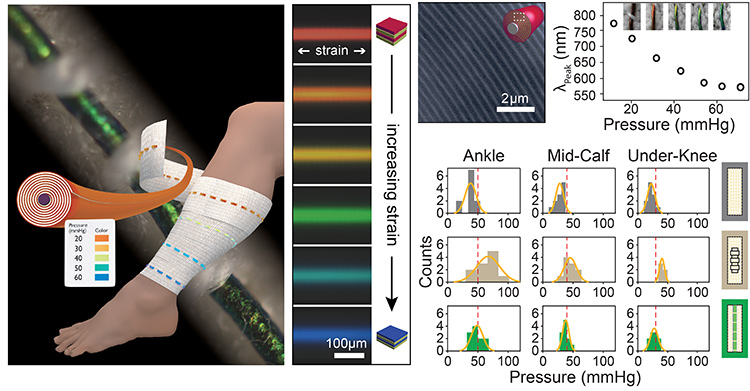 Left: Concept visualization overlaid onto an optical micrograph of a fiber integrated into bandage. Center: Color change of fiber with increasing strain. Top right: Scanning electron micrograph of a fiber’s multilayer cladding, showing its distinct radial periodicity, and chart of peak wavelengths of a fiber for varying bandage pressure, which is controlled by adjusting the strain applied to the bandage while wrapping. Bottom right: Data from volunteers applying unmarked bandages, bandages with geometric indicators, and bandages with integrated elastomeric photonic fibers to other volunteers’ legs. Dashed lines show the target pressure. [Enlarge figure]
Left: Concept visualization overlaid onto an optical micrograph of a fiber integrated into bandage. Center: Color change of fiber with increasing strain. Top right: Scanning electron micrograph of a fiber’s multilayer cladding, showing its distinct radial periodicity, and chart of peak wavelengths of a fiber for varying bandage pressure, which is controlled by adjusting the strain applied to the bandage while wrapping. Bottom right: Data from volunteers applying unmarked bandages, bandages with geometric indicators, and bandages with integrated elastomeric photonic fibers to other volunteers’ legs. Dashed lines show the target pressure. [Enlarge figure]
Compression bandages are widely employed to treat a variety of medical conditions—including venous ulcers,1 which affect more than two percent of people in industrialized countries, with associated healthcare cost estimated in the billions of U.S. dollars.2 Effective treatment of these ulcers using pressure garments requires the persistent application of a well-controlled pressure. But determining bandage pressure is frequently difficult, even when medical professionals are administering the compression. That, in turn, results in suboptimal treatment, prolonged therapy duration, and increased costs of care.3
Using mechano-responsive photonic fibers as bandage-integrated colorimetric pressure indicators, we have developed a system to provide medical practitioners and patients with reliable pressure feedback.4 To realize the pressure indicators, we integrated stretchable multilayer-clad photonic fibers, which emulate the key features found in a structurally colored tropical fruit,5 into elastic bandages. The fibers change color reversibly when subjected to strains of more than 100 percent, at which point the fibers still show elastic behavior even after 10,000 cycles of deformation. They can be designed to display all visible colors as they are stretched or deformed in other ways.
When the fibers are integrated into elastic bandages, their color becomes coupled to the bandage pressure via the strain exerted on the bandage upon application to a patient’s body. Our experiments indicate that untrained volunteers are able to apply target pressures very accurately and precisely when using bandages with integrated fiber sensors, which is not the case with commercially available compression bandages.4
We anticipate that our fiber-based colorimetric bandage pressure indicators will allow medical caregivers and patients to directly monitor pressure levels and adjust the spatial variation of compression across the treated area without any secondary equipment. This will help to track variations of pressure and indicate when a bandage requires adjustment, ultimately shortening therapy duration, reducing associated health care costs and increasing treatment success rate.
Researchers
Joseph Sandt and Mathias Kolle, Massachusetts Institute of Technology, Cambridge, Mass., USA
References
1. A.-A. Ramelet, Dermatol. Surg. 28, 6 (2002).
2. A.Y. Mousa et al. Vasc. Endovascular Surg. 48, 93 (2014).
3. K. Zarchi et al. JAMA Dermatol. 150, 730 (2014).
4. J.D. Sandt et al. Adv. Healthc. Mater. 7, 1800293 (2018).
5. M. Kolle et al. Adv. Mater. 25, 2239–2245 (2013).

